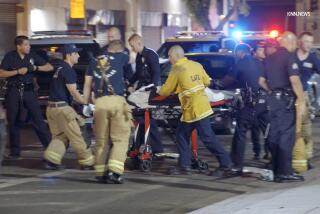2 Arrested in Torture Slaying of Transient
- Share via
A pack of homeless street youths--reputedly involved in a number of recent and alarmingly brutal attacks--tortured a transient to death in a condemned Hollywood building this weekend after an argument in which he apparently supported white supremacy, police said Tuesday.
Two of four alleged ringleaders in the attack are in custody and are expected to be arraigned today on charges of first-degree murder, said Detective Andrew Purdy of the Los Angeles Police Department. Both are 20-year-old men.
However, the detective added, as many as 15 youths may have witnessed or participated in the three-hour incident, which stretched from Saturday night into Sunday morning in the recesses of an abandoned apartment house in the 1800 block of Wilcox Avenue.
The still unidentified victim, a white man in his mid-30s whose hands were bound, was bludgeoned with metal and wooden poles, burned with candles and cigarettes, choked into unconsciousness and urinated upon before he died about 1 a.m. Sunday of a fractured skull, Purdy said. The suspects delivered their coup de grace by smashing his head with a brick, the detective said.
Hollywood, with its tawdry and star-decked boulevards, has long been a magnet for street people and runaways, and the area’s network of police and social workers have grown used to tales of predatory violence. At the Covenant House drop-in center, caseworkers have estimated that 10 youths a month arrive bleeding from stab wounds.
Even by those harsh standards, this weekend’s attack was notable, in part because police believe that the people involved--a loosely organized gang of homeless youths, some as young as 11--also are responsible for at least two other gruesome crimes in the past two years.
In December, 1992, a retarded woman with the mental capacity of an 8-year-old was lured by a group of young men and women into an abandoned building on Holly Drive, where she was hogtied, sodomized and strangled, Purdy said. When the suspects were convinced she had died, he said, they carved the satanic mark 666 into the flesh of her back. The woman survived and has since testified against her attackers, he said.
Then, on April 26, in an abandoned Hollywood Boulevard building known as The Hastings, 16-year-old Adam Pfiffer was beaten beyond recognition and murdered with a jack-hammer chisel, Purdy said.
In both cases, he said, members of three Hollywood gangs of homeless youths were implicated. The youths told authorities that they banded together for protection, with the boys calling themselves the Hollywood Dogs and the girls calling themselves the Hollywood Cats. A third group was known as the Hollywood Punks.
Authorities Tuesday officially listed this weekend’s attack as a hate crime because of its racial overtones, but Purdy said the same group of street people involved in the earlier attacks are believed to be implicated in Sunday’s murder.
About 20 people, including witnesses, were questioned before police arrested Edward (Scarface) Fernandez and James (Snoop) Snook, two transients who had been living in the Wilcox Avenue building.
Social workers said the two were well-known on the streets and had occasionally made use of the network of drop-in centers and shelters that offer food and refuge for Hollywood’s homeless. Fernandez, in particular, was a compelling figure, they said. Toothless and harelipped, his Native American face puffed and scarred, he had appeared on the boulevard as a lost and disfigured teen-ager who seemed bent on keeping up a tough front.
“When I first met him, he was not into real negative behavior--he just played it tough, and if you looked at him, you knew why,” said one social worker who spoke on condition of anonymity.
But about 18 months ago, she said, Fernandez disappeared, and it was not until August that she heard from other street people that he had been sent to Juvenile Hall. Whether that was true, she said, she never discerned, and she did not ask him about it when she ran into him about a week ago on the street. Nor did she ask him about his new address--the abandoned building on Wilcox that, for the past two months, had served as a “squat” for as many as 50 transients at a time.
Police and social workers said the building is in a section of Hollywood notorious for its trafficking in cocaine, heroin and speed. In fact, Purdy said, so many junkies drift in and out of the reeking apartments that one room has been designated as a “rig room” where people come expressly to shoot methamphetamines.
Among the addicts there are also runaways and homeless adolescents who sleep in the “squat” because they feel safer there than in the shelters, authorities said. This weekend, they added, there was the victim, the white man in his 30s who since his death has been variously described as a transient, a skinhead and “just a guy who liked to smoke dope and party.”
Purdy said Saturday night’s attack may have been triggered by the victim making comments in support of the white supremacist Aryan Brotherhood--a prison gang that, Purdy said, is believed to have stabbed Fernandez and slashed his face while he was serving time.
As the argument escalated, Purdy said, the older man tried to run, but his attackers ran him to ground.
“Every time he passed out from the pain, they would hit him again, inflicting enough pain to make him conscious again,” Purdy said.
It was not until nine hours after the man’s death, he said, that the body was found by members of the Guardian Angels citizen patrol group. People had been stepping over the body throughout the night, police said. Purdy said two more suspects are being sought in the crime.
Meanwhile, social workers say the incident has set off a maelstrom of gossip and fear on the streets. One caseworker had to cut off a phone call to smuggle an adolescent to safety because of rumors that her client had “snitched off” the accused murderers. But the social worker who knew Fernandez said her strongest reaction was surprise and sadness.
“I liked the kid,” she said. “He can be warm. He can be friendly. I wish he would have taken advantage of the services and gotten on with his life.”
More to Read
Sign up for Essential California
The most important California stories and recommendations in your inbox every morning.
You may occasionally receive promotional content from the Los Angeles Times.










